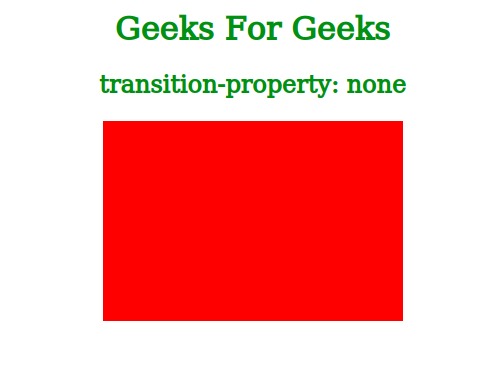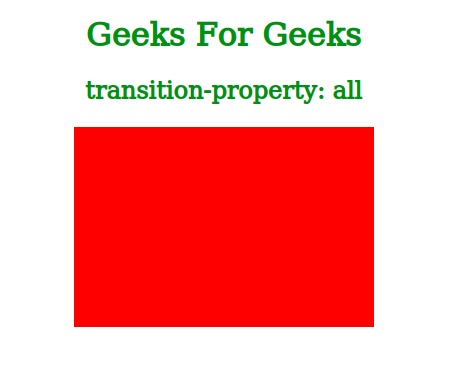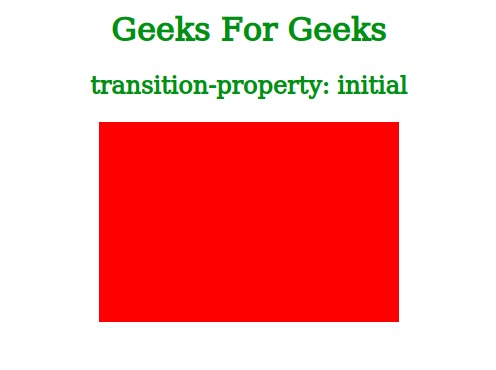过渡效果用于显示指定持续时间内元素属性的变化。 transition-property属性用于指定将发生过渡效果的CSS属性的名称。
用法:
transition-property:none | all | property | initial | inherit;
属性值:
- none:此值用于指定没有属性将获得过渡效果。
用法:
transition-property:none;
例:在下面的示例中,我们指定了所有属性都不会获得过渡效果。因此,如果将鼠标悬停在框上,其属性的变化将是突然的,而不是在指定的持续时间内从一个值过渡到另一个值。
<!DOCTYPE html> <html> <head> <title>CSS transition-property property</title> <style> .box{ background-color:red; width:300px; height:200px; margin:auto; transition-property:none; transition-duration:2s; } .box:hover{ background-color:pink; width:200px; height:150px; } h1, h2{ color:green; text-align:center; } </style> </head> <body> <h1>Geeks For Geeks</h1> <h2>transition-property:none</h2> <div class="box"></div> </body> </html>输出:

- all:所有CSS属性都会获得过渡效果。这也是此属性的默认值。
用法:
transition-property:all;
例:除了指定需要过渡效果的所有属性的名称之外,我们还可以将transition-property的all值使用。这将使我们能够显示所有属性的过渡效果,而无需单独指定它们的名称,如以下示例所示:
<!DOCTYPE html> <html> <head> <title>CSS transition-property property</title> <style> .box{ background-color:red; width:300px; height:200px; margin:auto; transition-property:all; transition-duration:2s; } .box:hover{ background-color:pink; width:200px; height:150px; } h1, h2{ color:green; text-align:center; } </style> </head> <body> <h1>Geeks For Geeks</h1> <h2>transition-property:all</h2> <div class="box"></div> </body> </html>输出:

- property:我们可以指定将应用过渡效果的CSS属性的名称。我们还可以通过用逗号分隔多个属性来指定它们。
用法:
transition-property:property;
例:我们在以下示例中为过渡效果指定了多个属性(即背景颜色,宽度和高度),方法是用逗号分隔。因此,当我们将鼠标悬停在框上时,可以看到框属性中的过渡。
<!DOCTYPE html> <html> <head> <title>CSS transition-property property</title> <style> .box{ background-color:red; width:300px; height:200px; margin:auto; transition-property:background-color, width, height; transition-duration:2s; } .box:hover{ background-color:pink; width:200px; height:150px; } h1, h2{ color:green; text-align:center; } </style> </head> <body> <h1>Geeks For Geeks</h1> <h2> transition-property: background-color, width, height</h2> <div class="box"></div> </body> </html>输出:

- initial:用于将此属性设置为其默认值。当我们不知道特定属性的默认值时,此值很有用。
用法:
transition-property:initial;
例:正如我们在下面的示例中将属性值指定为初始值一样,该属性的默认值(全部)将分配给transition-property。因此,当我们将鼠标悬停在框上时,所有CSS属性都会发生过渡效果。
<!DOCTYPE html> <html> <head> <title>CSS transition-property property</title> <style> .box{ background-color:red; width:300px; height:200px; margin:auto; transition-property:initial; transition-duration:2s; } .box:hover{ background-color:pink; width:200px; height:150px; } h1, h2{ color:green; text-align:center; } </style> </head> <body> <h1>Geeks For Geeks</h1> <h2>transition-property:initial</h2> <div class="box"></div> </body> </html>输出:

- inherit:用于指定此属性将从其父元素继承其值。
用法:
transition-property:inherit;
例:在下面的示例中,我们将属性值指定为继承,因此该框将继承其属性的transition-property值。但是在这种情况下,其父级的transition-property值将全部为默认值,因为我们尚未为其父级指定该值。因此,所有CSS属性都将发生过渡效果。
<!DOCTYPE html> <html> <head> <title>CSS transition-property property</title> <style> .box{ background-color:red; width:300px; height:200px; margin:auto; transition-property:inherit; transition-duration:2s; } .box:hover{ background-color:pink; width:200px; height:150px; } h1, h2{ color:green; text-align:center; } </style> </head> <body> <h1>Geeks For Geeks</h1> <h2>transition-property:inherit</h2> <div class="box"></div> </body> </html>输出:

支持的浏览器:transition-property属性支持的浏览器如下所示:
- 谷歌浏览器
- IE浏览器
- 火狐浏览器
- Opera
- 苹果浏览器
相关用法
- HTML Style transitionProperty用法及代码示例
- CSS top属性用法及代码示例
- CSS nav-up用法及代码示例
- CSS all属性用法及代码示例
- CSS nav-down用法及代码示例
- CSS nav-right用法及代码示例
- CSS right属性用法及代码示例
- CSS bleed属性用法及代码示例
- CSS will-change用法及代码示例
- CSS resize属性用法及代码示例
- CSS border-right用法及代码示例
- CSS columns属性用法及代码示例
- HTML li value用法及代码示例
- CSS overflow-y属性用法及代码示例
- CSS clip属性用法及代码示例
注:本文由纯净天空筛选整理自rituraj_jain大神的英文原创作品 CSS | transition-property Property。非经特殊声明,原始代码版权归原作者所有,本译文未经允许或授权,请勿转载或复制。
